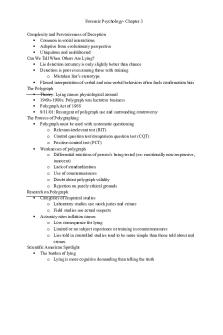Forensic 1 - Prof. Trinh, chapter guides. PDF

| Title | Forensic 1 - Prof. Trinh, chapter guides. |
|---|---|
| Course | Introduction to Forensic Science |
| Institution | Utah Valley University |
| Pages | 2 |
| File Size | 78.1 KB |
| File Type | |
| Total Downloads | 59 |
| Total Views | 145 |
Summary
Prof. Trinh, chapter guides....
Description
NAME: _____________________________ CHAPTER 1 REVIEW QUESTIONS 1. Define forensic science. • The application of science to both criminal and civil laws that are enforced by police agencies in a criminal justice system.
2. Who is known as “the father of forensic toxicology” and why? • Mathieu Orfila
3. Which of the following people did not make a contribution to forensic toxicology? a. Valentin Ross b. Alphonse Bertillon c. Carl Wilhelm Scheele d. Mathieu Orfila
4. What is Locard’s exchange principle? • Every contact leaves a trace
5. Which unit examines body fluids and organs for drugs and poisons? • Toxicology 6. Describe the criteria for admissibility of scientific evidence as laid out in Frye v. United States. • The evidence in question must be “generally accepted” by the scientific community.
7. What is the main difference between the testimony given by an expert witness and that given by a lay witness? • An expert witness offers opinions based on the fact that they’re an “expert” in the field. 8. List the three basic functions of a forensic scientist. • Proper collection of physical evidence • Analysis of evidence • Expert testimony 9. The judicial case that set forth the current guidelines for determining the admissibility of scientific examinations in the federal courts is Daubert v. Merril Dow Pharmaceuticals Inc. 10. In Kumho Tire Co., Ltd. v. Carmichael, the U.S. Supreme Court ruled that the “gatekeeping” role of a trial judge a. was restricted to scientific testimony. b. applied only to cases involving capital crimes. c. was subject to appeal by a higher court. d. applied to all expert testimony....
Similar Free PDFs

1- forensic anthro chapter 1
- 6 Pages

forensic law chapter 1 notes
- 5 Pages

Study Guides 2013 Chapter 1-8………………
- 81 Pages

Forensic Psychology Chapter 3
- 3 Pages

Chapter 11 Forensic Science
- 2 Pages

Forensic Psychology Chapter 4
- 4 Pages

Chapter 1 - Prof. David Rapien
- 5 Pages

Forensic Psych Chapter 2
- 4 Pages

Chapter 6 Forensic Science
- 3 Pages

Forensic Psychology Lecture 1
- 7 Pages

Forensic Linguistics Week 1
- 1 Pages
Popular Institutions
- Tinajero National High School - Annex
- Politeknik Caltex Riau
- Yokohama City University
- SGT University
- University of Al-Qadisiyah
- Divine Word College of Vigan
- Techniek College Rotterdam
- Universidade de Santiago
- Universiti Teknologi MARA Cawangan Johor Kampus Pasir Gudang
- Poltekkes Kemenkes Yogyakarta
- Baguio City National High School
- Colegio san marcos
- preparatoria uno
- Centro de Bachillerato Tecnológico Industrial y de Servicios No. 107
- Dalian Maritime University
- Quang Trung Secondary School
- Colegio Tecnológico en Informática
- Corporación Regional de Educación Superior
- Grupo CEDVA
- Dar Al Uloom University
- Centro de Estudios Preuniversitarios de la Universidad Nacional de Ingeniería
- 上智大学
- Aakash International School, Nuna Majara
- San Felipe Neri Catholic School
- Kang Chiao International School - New Taipei City
- Misamis Occidental National High School
- Institución Educativa Escuela Normal Juan Ladrilleros
- Kolehiyo ng Pantukan
- Batanes State College
- Instituto Continental
- Sekolah Menengah Kejuruan Kesehatan Kaltara (Tarakan)
- Colegio de La Inmaculada Concepcion - Cebu




